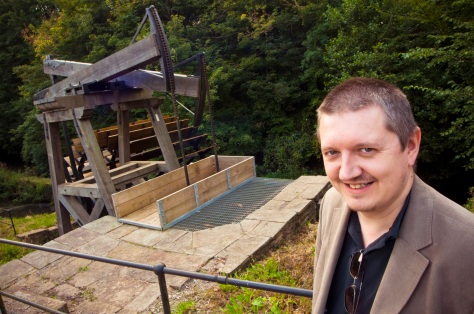
In the 1790s, the ironmasters of Merthyr Tydfil decided to build themselves a canal to bring their goods to market quicker, and on a larger scale than was previously possible along the turnpike. Their target markets were abroad, and they needed a port where they could transfer their goods from the canal barges onto ships to carried out into the wider world. Land surveys determined that the easiest route for this canal was south down the valleys past Pontypridd to the coastal plains beyond, where the River Taff flowed into the Bristol Channel. Cardiff at the time was a small town clinging to the shadow of its ruined castle, neither capital city nor important port. It lay on the route on this little canal, and more importantly to the south had miles of abundant saltmarsh – the perfect place for the ironmasters to build their seaport.
The canal was the Glamorganshire Canal, and the sea port of the ironmasters became known as Sea Lock Pond.
Although the canal continued to operate through to the end of 1951 (in increasing states of disrepair), new industry soon meant that new transport methods were needed. Iron and tin quickly gave way to coal as the main export of the valleys, and during the 1800s and early 1900s five private railroads sprang up to compete for the business of bringing this black gold down to the massive docks that were built to the east of Sea Lock Pond to try and meet the demand.
Cardiff grew rich, prosperous and influential as the middleman in all of this trade. The profits to be had from the coal trade were immense for the time (did you know that the world’s first £1 million deal was done in Cardiff’s Coal Exchange?) and they paid for many of Cardiff’s wonderful parks and its magnificent Civic Centre, and much more besides.
Without this trade, the Cardiff we all know and love today would be a very different – and probably much smaller – place. And yet, the debt Cardiff owes to this industrial history seems to be largely unknown to the good folks of Cardiff, and it’s one that is seldom clearly acknowledged whenever there is an historical exhibition put on in the city centre.
Perhaps the reason why is because this story doesn’t have a happy ending – not for the valleys anyway.
By the 1960s, most of this trade had ceased, having been in decline since the 1930s, and the docks closed down. Over the next 30 years, as the coal mines of the valleys were declared unprofitable and also closed down, the towns and villages of the valleys sank into a deep decline that they have yet to recover from.
It wasn’t just the coal mining that went. None of the industry that lined this industrial corridor at its height exists today. The Merthyr iron forges, the world’s two largest tinworks, the many deep coal mines, the chainworks factory, the chemical works, the bakeries, the power station, and much more besides … every last one of them has closed. Little has come in to replace them.
Today, Merthyr Tydfil is normally mentioned in the media because of its terrible unemployment rates and benefits culture, and things aren’t much better in many of the former coalmining towns and villages that dotted the canal’s route. The valleys had a very small population before the mines came along, and although the mines are long gone, the people have stayed in the places they have made their homes in. It’s difficult to see how their fortunes will drastically improve in my remaining lifetime, as the days of mass employment in heavy industry show no sign of imminent return.
Cardiff too fell on hard times for several decades, but thanks in part to the influx of European funds to transform the former docks into Cardiff Bay, and the money that has been attracted by the setting up of the Welsh Assembly Government, Cardiff’s fortunes have turned out quite different from the valleys. Indeed, Cardiff instead is competing to be one of the top shopping destinations in the whole UK, and its council has announced ambitious plans for a new business district to further boost the local economy.
I’m originally from Yorkshire, a proud area that makes a point of teaching all of its children its major history, which dates back to Roman times. You have a proud and unique history too, and I’d urge you to put it proudly on display before it becomes lost and forgotten.
If you want to learn more about this industrial history, then I highly recommend reading the excellent two-volume set “The Glamorganshire and Aberdare Canal”, by Stephen Rowson and Ian L. Wright, available from Black Dwarf Lightmoor. You can also see some of my own writings about this at my Merthyr Road photography project.
Stuart is an amateur photographer who was first struck by the ruins of South Wales’ industrial past back in 2007 as he commuted past them every day to and from work. Over the last five years, he’s been slowly exploring and blogging about a history that he’s worried has already been forgotten. You can find his work at his blog.
Stuart was photographed at the Melingriffith Water Pump in Whitchurch by Jon Poutney
***
- Sign up for the weekly We Are Cardiff newsletter
- Check out what’s going on with We Are Cardiff Press
- Like us on Facebook
- Squawk @ us on Twitter @wearecardiff
- Follow us on Instagram/WeAreCardiff

